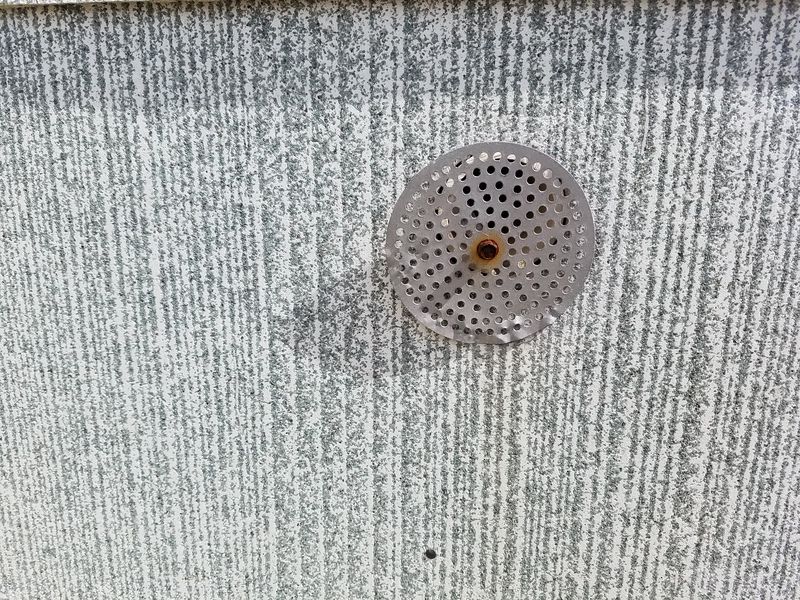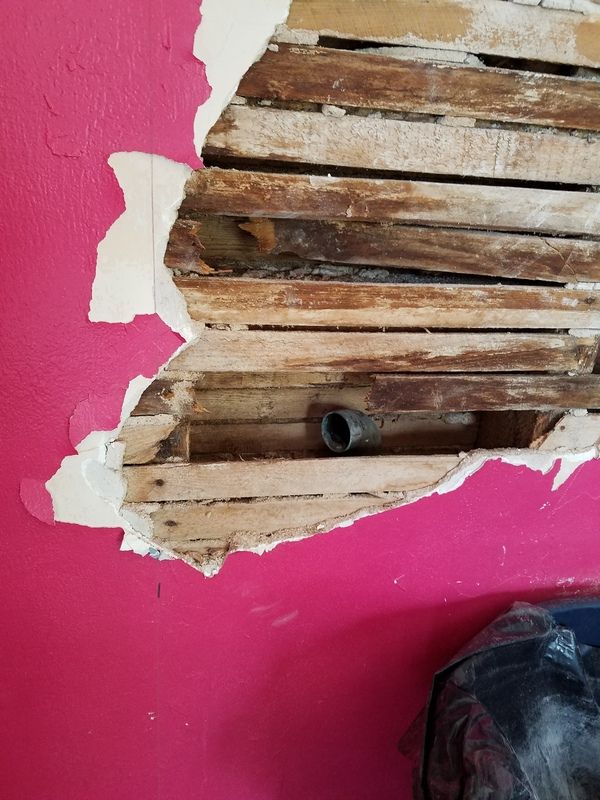 
Over 698,000 strictly plumbing related posts
Plumbing education, information, advice, help and suggestions are provided by some of the most experienced plumbers who wish to "give back" to society. Since 1996 we have been the best online (strictly) PLUMBING advice site. If you have questions about plumbing, toilets, sinks, faucets, drains, sewers, water filters, venting, water heating, showers, pumps, and other strictly PLUMBING related issues then you've come to the right place. Please refrain from asking or discussing legal questions, or pricing, or where to purchase products, or any business issues, or for contractor referrals, or any other questions or issues not specifically related to plumbing. Keep all posts positive and absolutely no advertising. Our site is completely free, without ads or pop-ups and we don't tract you. We absolutely do not sell your personal information. We are made possible by: 
|
|
Author:
Don411 (IN)
Making some progress with the plumbing in this old house. I'm gradually replacing all the supply piping with 3/4" copper mains with 1/2" branches to individual fixtures, this is helping with water pressure and flow issues.
One issue I am trying to solve is this plumbing mess where the drains leave the house. When the 1/2 bath was added, they ran the drain into what was the cleanout as it leaves the house. They added a second whole house trap, but no vent, so the toilet constantly has flushing issues. It slurps and gurgles as the bowl fills, then won't flush until the bowl is completely full with water.
Here is what I started with:

I have made some progress by re-routing the kitchen/laundry line to eliminate the portion with negative slope. That got rid of the periodic clogs in that line and it flows much better now.

I would like to move that second 3" waste from the 1/2 bath and combine it with the kitchen/laundry line into a single 3" coming in where the kitchen line does now. To do that, I would like to replace that old cast iron san tee with a pvc wye and bring it right into the cast iron hub. How do I attach the PVC to teh cast iron hub?
|
|
Post Reply
|
|
|
Author:
m & m (MD)
I use a grinder with metal wheel to cut fitting flush with hub (will take a few cuts but do-able). Then use a 1/4" drill bit and drill out lead full circumference of hub to remove remaining fitting from hub.
|
|
Post Reply
|
|
|
Author:
steve (CA)
After the CI tee/lead/oakum is removed from the hub, a rubber donut can be inserted into the hub and then a stub of PVC pipe is inserted into the donut. 
|
|
Post Reply
|
|
|
Author:
packy (MA)
i would simply cut the lower part of the fitting with a sawzall leaving a good inch of cast iron. then use a 4 inch no hub banded coupling to attach the PVC to the stub.
how do you know the flushing problem is not related to an improperly vented drain?
|
|
Post Reply
|
|
|
Author:
hj (AZ)
The addition is connected at the correct point. Just get rid of that "whole house trap", (I would also get rid of the cast iron one at the same time).
|
|
Post Reply
|
|
|
Author:
Don411 (IN)
Do I need any type of sealant with that rubber donut?
Packy, I may try your way first. There is already a no-hub to the right (out of the picture) where a section of straight CI was replaced with PVC.
I think I have 2 issues with that 1/2 bath toilet. First, there is no vent ahead of the second whole house trap like on the other side. Second, the sink and toilet share a single 1 1/2" vent through the wall, here:


So I think the combination of no foundation vent by the whole house trap and an inadequate fixture vent is creating the performance issues. I am planning to add a shower to make the 1/2 bath a full bath, and in the process want to clean up this mess and also properly connect the fixture to the vent stack going through the roof. When I demo for the remodel, I will be able to run a new vent up through the wall and connect it to the stack in the attic.
The main waste coming from the upstairs toilet is vented through the roof as 1 1/2" copper. When I demo that bath, I plan to re-do that whole waste line with PVC with 3" running right up to the roof as a vent. The plan is to make the 1/2 bath into a full bath so we have someplace to shower while I re-do the upstairs.
If you recall, when I demo'ed the plaster in the bedroom next to the upstairs bath, I found the vent for the bathroom sink just ended inside the wall cavity:

I got the moisture and mold cleaned up, and extended that copper with 1 1/2" PVC using a Fernco sleeve up into the attic. It terminates in the attic with an AAV on it for now, and will eventually connect into the new 3" vent stack.
Edited 2 times.
|
|
Post Reply
|
|
|
Author:
packy (MA)
unscrew the AAV in the attic to see if the toilet flushes better.
|
|
Post Reply
|
|
|
Author:
Don411 (IN)
The AAV is on the upstairs loop, toilet up there has no issues. It's the /12 bath downstairs on the PVC loop in the pic that is having issues.
|
|
Post Reply
|
|
|
Author:
hj (AZ)
deleted
Edited 1 times.
|
|
Post Reply
|
|
|
Author:
packy (MA)
deleted ???? must have been going to make a D-backs prediction.
|
|
Post Reply
|
|
|
Author:
hj (AZ)
No, it was just related to your observation about the AAV, until I noticed that there was a vent hole in the side of the house which apparently is for this area, even though conditions imply differently.
|
|
Post Reply
|
|
|
Author:
sum (FL)
Not a plumber.
I think it makes sense to combine the 1/2 bath drain with your kitchen/laundry drain then tie into your existing CI line.
To me it seems more logical to use the same branch the PVC 3" is currently tied into.
I would leave the CI santee on it's back alone and make it into another CO access. Personally I don't like a section of CI followed by a section of PVC back to a section of CI again. Nothing wrong just my OCD I guess.
Do you need that 3" PVC trap? Aren't all your existing fixtures already trapped?
|
|
Post Reply
|
|
|
Author:
hj (AZ)
'House traps' are an anachronism from the dark ages. Supposedly, they are to supplement the fixture traps, but in practice, they cause many more problems that they have ever solved.
|
|
Post Reply
|
|
|
Author:
sum (FL)
I don't quite get whole house traps. I thought they were redundant if every fixture is already trapped. But I read that some places may have untrapped floor drains and in that case a whole house trap would protect that. But then isn't the gas from the rest of the house going freely moving to the untrapped floor drain? Oh I remember reading somewhere don't remember where but it mentioned that whole house traps are more important for septic tanks then regular city sewers is this true? If so why?
|
|
Post Reply
|
|
|
Author:
Don411 (IN)
Sum, I'm with you on the whole house trap thing, but apparently they are code in all parts of New York State. Thinking back, two other houses we've owned on LI with cesspools had them, this house has sewers and has one.
The idea here is get everything flowing through ONE trap with ONE foundation vent. The CI that goes to the right goes upstairs, and that will all be replaced with PVC once I remodel the upstairs bath.
Once all completed, the only CI left will be the foundation vent, the trap and the short section where it goes through the foundation. The sewer cleanout in the lawn in PVC. None of this is leaking, and once it does, I'll have a pro plumber come in and replace. Heck if I do OK on taxes this year I an inclined to call a pro to do all of it....
|
|
Post Reply
|
Please note:
- Inappropriate messages or blatant advertising will be deleted. We cannot be held responsible for bad or inadequate advice.
- Plbg.com has no control over external content that may be linked to from messages posted here. Please follow external links with caution.
- Plbg.com is strictly for the exchange of plumbing related advice and NOT to ask about pricing/costs, nor where to find a product (try Google), nor how to operate or promote a business, nor for ethics (law) and the like questions.
- Plbg.com is also not a place to ask radiant heating (try HeatingHelp.com), electrical or even general construction type questions. We are exclusively for plumbing questions.
Search for plumbing parts on our sponsor's site:
Special thanks to our sponsor:

|









